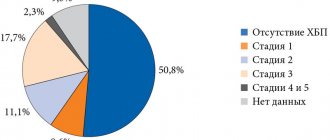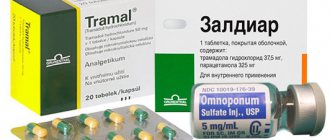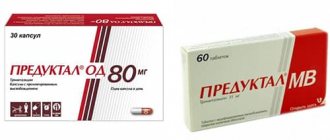Novalgin tablets 50 mg+200 mg+200 mg 10 pcs.
Paracetamol reduces the effectiveness of uricosuric drugs. The simultaneous use of paracetamol in high doses increases the effect of anticoagulants (decreased synthesis of procoagulant factors in the liver). Inducers of microsomal liver enzymes, ethanol and hepatotoxic drugs increase the production of hydroxylated metabolites of paracetamol, which makes it possible to develop severe intoxications even with a small overdose. Long-term use of barbiturates reduces the effectiveness of paracetamol. When used simultaneously with ethanol, the risk of developing acute pancreatitis increases. Myelotoxic drugs enhance the hematotoxicity of paracetamol. Caffeine is an adenosine antagonist (larger doses of adenosine may be required). With the simultaneous use of caffeine and inducers of microsomal liver enzymes, it is possible to enhance metabolism and increase the clearance of caffeine; inhibitors of microsomal liver enzymes - decreased metabolism of caffeine in the liver. Mexiletine reduces caffeine excretion by up to 50%; Nicotine increases the rate of caffeine elimination. Monoamine oxidase inhibitors, furazolidone, procarbazine and selegiline - large doses of caffeine can cause the development of dangerous cardiac arrhythmias or severe. increased blood pressure. Caffeine reduces the absorption of calcium from the gastrointestinal tract; reduces the effect of narcotic and sleeping pills; increases the excretion of lithium drugs in the urine; accelerates absorption and enhances the effect of cardiac glycosides, increasing their toxicity. Concomitant use of caffeine with β-blockers may; lead to mutual suppression of therapeutic effects; with β-adrenomimetics - to additional stimulation of the central nervous system and other additive: toxic effects. Caffeine may decrease the clearance of theophylline and possibly other xanthines, increasing the potential for additive pharmacodynamic and toxic effects. Propyphenazone may enhance the effect of oral hypoglycemic agents, sulfonamide drugs, anticoagulants, the ulcerogenic effect of glucocorticosteroids, and reduce the effectiveness of potassium-sparing diuretics. Absorption of the components of the drug may be reduced when used simultaneously with cholestyramine, m-anticholinergics, and antidepressants.
Novalgin 500 mg, 20 tablets
Compound
1 tablet contains metamizole sodium 500 mg.
pharmachologic effect
pharmachologic effect
- antispasmodic, analgesic, antipyretic, anti-inflammatory.
Blocks cyclooxygenase and reduces PG synthesis.
Pharmacokinetics
After oral administration, it is hydrolyzed in the gastrointestinal tract to form an active metabolite - 4-methylaminoantipyrine (4-MMA), which is absorbed in the liver into 4-aminoantipyrine (4-AA), as well as pharmacologically inactive metabolites. After oral administration of 1 g of metamizole, 58% of 4-MMA and 48% of 4-AA are bound to plasma proteins.
The effective therapeutic concentration in plasma of 4-MMA is achieved after 20–40 minutes, Cmax after 2 hours.
Indications
- Severe acute or chronic pain syndrome due to injuries and postoperative pain syndrome, colic, cancer and other conditions where other therapeutic measures are contraindicated.
- Fever resistant to other treatments
Use during pregnancy and breastfeeding
Baralgin M is contraindicated for pregnant women, nursing mothers and children in the first three months of life.
Contraindications
- Hypersensitivity to metamizole sodium and other components of the drug, as well as other pyrazolones (phenazone, propyphenazone) or pyrazolidines (phenylbutazone, oxyphenbutazone), including, for example, a history of the development of agranulocytosis when taking one of these drugs. — Disorders of bone marrow hematopoiesis (for example, after treatment with cytostatics) or diseases of the hematopoietic system. - History of bronchospasm or other anaphylactic reactions (eg, urticaria, rhinitis, angioedema) when taking analgesic drugs such as salicylates, paracetamol, diclofenac, ibuprofen, indomethacin, naproxen. — Congenital deficiency of glucose-6-phosphate dehydrogenase (risk of hemolysis). — Children's age (up to 15 years). — Pregnancy (first and third trimester). - Lactation period. — Acute intermittent hepatic porphyria (risk of developing porphyria attacks). If you have one of these diseases or conditions, consult your doctor before taking this medicine. With caution: - Hypotension (systolic blood pressure below 100 mm Hg), decreased circulating blood volume, hemodynamic instability (myocardial infarction, multiple trauma, incipient shock), incipient heart failure, high fever (increased risk of a sharp decrease in blood pressure) . — Diseases in which a significant decrease in blood pressure may be of increased danger (patients with severe coronary heart disease and stenosis of the cerebral arteries). - Alcoholism. — Bronchial asthma, especially in combination with concomitant polypous rhinosinusitis; chronic urticaria and other types of atopy (allergic diseases, in the development of which a hereditary predisposition to sensitization plays a significant role: hay fever, allergic rhinitis, etc.) (increased risk of developing anaphylactic/anaphylactoid reactions). - Alcohol intolerance (reaction to even small amounts of certain alcoholic beverages with symptoms such as itching, lacrimation and severe redness of the face) (increased risk of developing anaphylactic/anaphylactoid reactions). - Intolerance to dyes (for example, tartrazine) or preservatives (for example, benzoates) (increased risk of anaphylactic/anaphylactoid reactions). - Severe liver and kidney dysfunction (low doses are recommended due to the possibility of slowing the excretion of metamizole sodium). — Pregnancy (second trimester). If you have one of these diseases or conditions, consult your doctor before taking this medicine.
Side effects
Side effects were classified according to the recommendations of the World Health Organization: very common (≥10%); often (≥1%, <10%); uncommon (≥0.1%, <1%); rare (≥0.01%, <0.1%); very rare (<0.01%); frequency unknown (from available data it is not possible to estimate the frequency of side effects). Cardiac disorders
Not known: Kounis syndrome (allergic angina or allergic myocardial infarction).
Immune system disorders
Rare: Metamizole sodium may cause anaphylactic or anaphylactoid reactions, which can be severe and life-threatening; In some cases, anaphylactic reactions can be fatal.
In case of development of anaphylactic/anaphylactoid reactions, it is necessary to immediately stop taking the drug, take measures to provide emergency medical care to patients, and conduct a detailed clinical blood test.
These reactions can occur even if the drug has been used many times before without any complications. These drug reactions may occur immediately or several hours after taking metamizole sodium, but they usually occur within one hour.
Typically, more mild anaphylactic or anaphylactoid reactions manifest themselves in the form of skin and mucous membrane symptoms (itching, burning, flushing, urticaria, swelling), shortness of breath or complaints from the gastrointestinal tract. Milder reactions may progress to severe forms with generalized urticaria, severe angioedema (especially involving the larynx), severe bronchospasm, cardiac arrhythmias, a sharp decrease in blood pressure (sometimes preceded by an increase in blood pressure) and the development of circulatory shock.
Very rare: in patients with a complete or incomplete combination of bronchial asthma, recurrent polyposis of the nose and paranasal sinuses and intolerance to acetylsalicylic acid or other non-steroidal anti-inflammatory drugs (including a history), intolerance reactions usually manifest themselves in the form of attacks of bronchial asthma. Frequency unknown: anaphylactic shock.
Skin and subcutaneous tissue disorders
Uncommon: In addition to the manifestations of anaphylactic/anaphylactoid reactions on the skin and mucous membranes listed above, a fixed drug rash may occur infrequently. Rarely: rash may occur. Very rare: possible development of Stevens-Johnson syndrome or Lyell's syndrome (toxic epidermal necrolysis).
Blood and lymphatic system disorders
Rarely: leukopenia. Very rare: agranulocytosis (including fatal cases), thrombocygopenia. Frequency unknown: aplastic anemia, pancytopenia, including fatal cases. These reactions are immunological in nature. They can occur even if the drug has been taken many times before without any complications.
Typical symptoms of agranulocytosis are lesions of the mucous membranes (oral cavity and pharynx, anorectal region and genital organs), sore throat, and fever. It should be borne in mind that if the patient receives antibiotic therapy, then the typical manifestations of agranulocytosis may be minimally expressed. The erythrocyte sedimentation rate is significantly increased, while lymph node enlargement is mild or absent.
Typical symptoms of thrombocytopenia are an increased tendency to bleeding and the appearance of petechiae on the skin and mucous membranes. In the event of the development of the above disorders in the blood and lymphatic system, it is necessary to stop taking the drug and conduct a detailed clinical blood test (see section “Special instructions”).
Interaction
With cyclosporine
Metamizole sodium may decrease serum concentrations of cyclosporine, so cyclosporine concentrations should be monitored when coadministered.
With other non-narcotic analgesics
The simultaneous use of metamizole sodium with other non-narcotic analgesics may lead to mutual enhancement of toxic effects.
With tricyclic antidepressants, oral contraceptives, allopurinol
Tricyclic antidepressants, oral contraceptives, allopurinol disrupt the metabolism of metamizole sodium in the liver and increase its toxicity.
With barbiturates, phenylbutazone and other inducers of microsomal liver enzymes
Barbiturates, phenylbutazone and other inducers of microsomal liver enzymes weaken the effect of metamizole sodium.
With sedatives and tranquilizers
Sedatives and tranquilizers enhance the analgesic effect of metamizole sodium. With the simultaneous use of metamizole sodium and chlorpromazine, severe hypothermia may develop.
With drugs that are highly bound to protein (oral hypoglycemic agents, indirect anticoagulants, glucocorticosteroids and indomethacin)
Metamizole sodium, displacing oral hypoglycemic agents, indirect anticoagulants, glucocorticosteroids and indomethacin from its binding to plasma proteins, enhances their effect.
With myelotoxic drugs
Myelotoxic drugs enhance the hematotoxicity of metamizole sodium.
With methotrexate
The addition of metamizole sodium to methotrexate treatment may enhance the hematotoxic effects of methotrexate, especially in elderly patients.
Therefore, this combination should be avoided.
With thiamazole and sarcolysine
Thiamazole and sarcolysin increase the risk of developing leukopenia.
With codeine, H2-histamine receptor blockers and propranolol
Codeine, H2-histamine receptor blockers and propranolol enhance the effects of metamizole sodium.
Radiocontrast agents, colloidal blood substitutes and penicillin should not be used during treatment with metamizole sodium (increased risk of anaphylactic/anaphylactoid reactions).
With acetylsalicylic acid
When used together, metamizole sodium may reduce the effect of acetylsalicylic acid on platelet aggregation. Therefore, this combination should be used with caution when treating patients taking low doses of acetylsalicylic acid for cardioprotection (prevention of thrombus formation). With bupropion
Metamizole sodium may reduce the concentration of bupropion in the blood, which should be taken into account when using metamizole sodium and bupropion simultaneously.
How to take, course of administration and dosage
In tablets, adults are prescribed 1-2 tablets. Baralgin up to 4 times a day.
The maximum daily dose is no more than 8 tablets.
Overdose
Symptoms
In case of overdose, the following symptoms may occur: nausea, vomiting, abdominal pain, decreased renal function/acute renal failure with oliguria (for example, due to the development of interstitial nephritis), more rarely, symptoms from the central nervous system (dizziness, drowsiness, tinnitus, delirium, impaired consciousness, coma, convulsions) and a sharp decrease in blood pressure (sometimes progressing to shock), as well as heart rhythm disturbances (tachycardia), hypothermia, shortness of breath, acute agranulocytosis, hemorrhagic syndrome, acute liver failure, paralysis of the respiratory muscles. After high doses, excretion of a non-toxic metabolite (rubazonic acid) through the kidneys may cause red urine.
Treatment
If no more than 1-2 hours have passed after taking the drug, you can induce vomiting and perform gastric lavage through a tube; give saline laxatives, activated carbon. In case of overdose, forced diuresis is indicated. The main metabolite (4-N-methylaminoantipyrine) can be eliminated by hemodialysis, hemofiltration, hemoperfusion or plasma filtration. With the development of convulsive syndrome, intravenous administration of diazepam and fast-acting barbiturates.
Special instructions
In patients suffering from bronchial asthma, taking the drug can provoke the development of an attack.
Storage conditions
In a place protected from light, at a temperature of 8–25 °C
Best before date
4 years
Active substance
Metamizole sodium
Conditions for dispensing from pharmacies
On prescription
Dosage form
pills
Purpose
Pregnant women only 2nd trimester as prescribed by a doctor, Children as prescribed by a doctor, For adults, Children over 15 years old
Indications
Colds, Flu, Cholelithiasis, Migraine, Sciatica, Arthrosis and arthritis, Urolithiasis, Insect bites
MAIN IDEA : NOVALGIN® IS A DRUG CAPABLE OF REDUCING SYMPTOMS IN PRIMARY DYSMENORRHOEA, WHILE HAVING THE BEST SAFETY AND TOLERABILITY PROFILE.
The active ingredients of Novalgina are CAFFEINE, PARACETAMOL and PROPYPHENAZONE. This combined composition reduces the risk of side effects.
One NOVALGIN® tablet contains: 200 mg of paracetamol, 200 mg of propyphenazone and 50 mg of caffeine, which allows for rapid pain relief.
PARACETAMOL has a rapid analgesic effect (maximum concentration in the blood develops 0.5-2 hours after administration), and has a better safety and tolerability profile compared to other non-selective non-steroidal anti-inflammatory drugs.
PROPYPHENAZONE is an analgesic and antipyretic from the pyrazolone group, has a pronounced analgesic effect. Rapidly absorbed from the gastrointestinal tract (maximum concentration in the blood develops 30 minutes after oral administration). Its analgesic effect is associated with a stimulating effect on the production of endorphins and serotonin. Does not affect the gastrointestinal tract and kidneys! The introduction of propyphenazone into Novalgin avoids stress on the gastrointestinal tract and kidneys, thereby reducing the risk of side effects.
Together, paracetamol and propyphenazone act unidirectionally, which manifests itself in both summation and a significant increase in pharmacological action (potentiation). The analgesic effect of propyphenazone is enhanced by paracetamol by increasing its level in the blood and prolonging its half-life.
CAFFEINE, due to its stimulating effect on the psychomotor centers of the brain, has an analeptic effect, enhances the effect of analgesics, eliminates drowsiness and fatigue, and increases physical and mental performance. Thanks to these properties, NOVALGIN® exhibits not only analgesic and antipyretic effects, but also has a psychostimulating effect, which is important in the treatment of dysmenorrhea.
NOVALGIN® is a drug that has a complex effect: analgesic, anti-inflammatory, psychostimulant.
NOVALGIN® has one of the highest safety profiles in its group , especially in relation to the gastrointestinal tract. The use of the drug is permitted even during periods of exacerbation of gastric and duodenal ulcers (with caution).
NOVALGIN® ADVANTAGES:
- PROLONGED ACTION: NOVALGIN® provides a longer period of therapeutic action of drugs than conventional drugs with the same substances, due to the synergistic effect of the interaction of propyphenazone and paracetamol.
- FAST ACTION - achieved due to the presence of caffeine, which accelerates the absorption process of components
- REDUCING THE DOSE / INCREASING THE INTERVAL OF ADMINISTRATION - the components of the drug potentiate the effect of each other
- REDUCING THE RISK OF SIDE EFFECTS
- REDUCES DROWSLY AND IRRITABILITY, IMPROVES MOOD AND INCREASES vigour, due to the presence of caffeine in the formula
NOVALGIN® FOR THE TREATMENT OF DYSMENORRHOEA is prescribed from the 1st day of the menstrual cycle. The advisability of using Novalgin during the first 48–72 hours after the onset of menstruation is determined by the fact that prostaglandins are released into the menstrual fluid in maximum quantities in the first 48 hours of menstruation. It is also possible to use the drug 2-3 days before the onset of painful symptoms (preventive regimen) or when pain appears (symptomatic regimen). The duration of taking the drug for the treatment of dysmenorrhea usually does not exceed 5 days. NOVALGIN®
INDICATIONS FOR USE:
Pain syndrome of weak and medium intensity during painful menstruation (dysmenorrhea), in the absence of organic changes. Pain syndrome of weak and medium intensity of various origins: headache, migraine, toothache, arthralgia, myalgia. In complex therapy as an antipyretic in febrile conditions on background of infectious and inflammatory diseases (ARVI, influenza, etc.).
NOVALGIN® DOSAGE AND ADMINISTRATION:
Inside, after meals, with a small amount of liquid.
Adults: 1-2 tablets 1-3 times a day.
The daily dose should not exceed 6 tablets.
Adolescents from 12 to 18 years old, ½–1 tablet up to three times a day.


